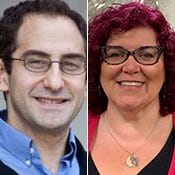Key points
Use and share these resources about the Reaching People with Disabilities through Healthy Communities project and improving health in your community.
Podcast series
These interviews with key participants of the Reaching People with Disabilities through Healthy Communities project will help you understand each phase of the Inclusive Healthy Communities Model.
Episodes
Introduction: Reaching People with Disabilities through Healthy Communities–Project Overview
Listen: Introduction: Reaching People with Disabilities through Healthy Communities–Project Overview

Listen to Karma Harris describe the Reaching People with Disabilities through Healthy Communities project. Harris also explains how the Inclusive Healthy Communities Model was used to implement new policy, systems, and environmental strategies (PSEs) to address issues that people with disabilities face in their communities.
Phase 1: Commitment
Listen: Phase 1: Commitment

Listen to David Ellsworth, State Expert Advisor for Ohio
- Talk about the first phase of the Inclusive Healthy Communities Model, Commitment.
- Discuss the importance of partnership development for community engagement.
- Provide tips for how to include people with disabilities in community coalitions.
Phase 2: Assessment and Training
Listen: Phase 2: Assessment and Training

Listen to Angela Weaver, State Expert Advisor for Oregon
- Talk about the second phase of the Inclusive Healthy Communities Model, Assessment and Training.
- Discuss the importance of ongoing education, engagement, and training during the entire project process.
- Explain how community coalitions can use the Community Health Inclusion Index (CHII) to identify local assets to build upon and existing gaps to address.
Phase 3: Prioritization and Planning
Listen: Phase 3: Prioritization and Planning

Listen to Dr. Meg Traci, State Expert Advisor for Montana, talk about the third phase of the Inclusive Healthy Communities Model, Prioritization and Planning. Dr. Traci also explains how she helped two community coalitions use the data from the Assessment Phase to develop their community action plans.
Phase 4: Implementation
Listen: Phase 4: Implementation

Listen to David Ellsworth, State Expert Advisor for Ohio
- Talk about the fourth phase of the Inclusive Healthy Communities Model, Implementation.
- Explain how he worked with two community coalitions to successfully implement PSE changes.
- Discuss project sustainability.
Phase 5: Evaluation
Listen: Phase 5: Evaluation

Listen to Yochai Eisenberg from the University of Illinois at Chicago and the National Center on Health, Physical Activity, and Disability (NCHPAD) and Rhonda Rosenburg, New York State Expert Advisor
- Talk about the fifth phase of the Inclusive Healthy Communities Model, Evaluation.
- Discuss the Reach, Effectiveness, Adoption, Implementation, Maintenance (RE-AIM) framework used for the evaluation of the Reaching People with Disabilities through Healthy Communities project.
- Give an overview of the evaluation activities that took place in two communities.
Phase 6: Communication and Dissemination
Listen: Phase 6: Communication and Dissemination

Listen to Iowa State Expert Advisor Maggie Ferguson and NCHPAD Project Partner Allison Hoit Tubbs talk about:
- The sixth phase of the Inclusive Healthy Communities Model, Communication and Dissemination.
- Social media planning and evaluation.
- The importance of inclusive communication activities.
Other resources
NACDD's Reaching People with Disabilities through Healthy Communities project website
The National Association of Chronic Disease Directors' (NACDD) website about the Reaching People with Disabilities through Healthy Communities project shows how NACDD has helped CDC-funded communities navigate the healthy community change process. The communities have improved access and opportunity for healthy eating, physical activity, prevention or reduction of tobacco use, and general accessibility improvements through establishing new and supporting PSE strategies, with a principal focus on disability inclusion. This process closely resembles previous healthy community projects like Action Communities for Health Innovation and EnVironmental changE (ACHIEVE).
Mobilizing for Action through Planning and Partnerships (MAPP)
The National Association of County and City Health Officials' (NACCHO) Mobilizing for Action through Planning and Partnerships (MAPP) is a community-driven strategic planning process for improving community health. Facilitated by public health leaders, this framework helps communities apply strategic thinking to prioritize public health issues and identify resources to address them.
CDC's Community Health Assessment and Group Evaluation (CHANGE) tool
CDC's Community Health Assessment aNd Group Evaluation (CHANGE) is a data collection tool and planning resource for community members who want to make their community a healthier one. This tool walks community team members through the assessment process, helping them define and prioritize possible areas of improvement. Having this information as a guide, community team members can create sustainable, community-based improvements that address the root causes of chronic diseases and related risk factors. It can be used annually to assess current PSE change strategies and offer new priorities for future efforts.
